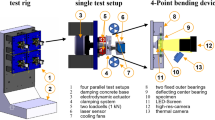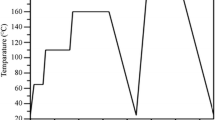Abstract
In order to improve the fatigue resistance of polymer-matrix composites by materials design, or to conceive micromechanics based models for life predictions, the underlying micromechanisms must be understood. Experimental investigations have revealed fibre-bridged cracking as a toughening micromechanism that retards further fatigue crack growth in a unidirectional 0° carbon-fibre-reinforced epoxy. The bridging fibres exert a closing traction on the crack surfaces, thereby reducing the driving force for crack growth. In this study, the growth of bridged cracks has been quantified by a surface replication technique. The da/dN–ΔK curve defined in terms of nominal stress-intensity factors shows a crack retarding behaviour. The crack growth curve can be replotted in terms of the effective stress-intensity factor where the contribution of the cohesive crack surface forces from the bridging fibres are taken into account. This curve falls somewhat closer to that of the neat matrix material, but the difference is still considerable, and it shows a decelerating propagation. Therefore, there must be other active toughening mechanisms besides fibre bridging, that slow the crack propagation down, and account for the fatigue resistant behaviour of the tested material. Ways by microstructural design to promote the fatigue resistant mechanisms are discussed.
Similar content being viewed by others
References
Talreja, R., 'Fatigue of Fiber Composites', in T. W. Chou (ed.), Structure and Properties of Composites, VCH, Weinheim, 1993, pp. 583–606.
Zheng, D. and Ghonem, H., 'Fatigue crack growth of SM-1240-TIMETAL-21S metal matrix composites at elevated temperatures', Metallurgical and Materials Transactions 26A, 1995, 2469–2478.
Talreja, R., 'A conceptual framework for the interpretation of MMC fatigue', Materials Science and Engineering A200, 1995, 21–28.
McMeeking, R. M. and Evans, A. G., 'Matrix fatigue cracking in fiber composites', Mechanics of Materials 9, 1990, 217–227.
Bao, G. and McMeeking, R. M., 'Fatigue crack growth in fiber-reinforced metal-matrix composites', Acta Metallurgica et Materialia 42, 1994, 2415–2425.
Lindhagen, J. E., Gamstedt, E. K., and Berglund, L., 'Application of bridging law concepts to short fibre composites Part 3: Bridging law derivation from experiemental crack profiles', Composites Science and Technology 60, 2000, 2883–2894.
Gamstedt, E. K. and Talreja, R., 'Fatigue damage mechanisms in unidirectional carbon-fibre-reinforced plastics', Journal of Materials Science 34, 1999, 2535–2546.
Gamstedt, E. K., Berglund, L. A., and Peijs, T., 'Fatigue mechanisms in unidirectional glass-fibre-reinforced polypropylene', Composites Science and Technology 59, 1999, 759–768.
Ritchie, R. O., Yu, W., and Bucci, R. J., 'Fatigue crack propagation in ARALL laminates: Measurement of the effect of crack-tip shielding from crack bridging', Engineering Fracture Mechanics 32, 1989, 361–377.
Luke,M., Marissen, R., Schulte, K., Maldfeld, E., and Nowack, H., 'Experimental and Numerical Through-Thickness Stress/Strain-Analysis of Notched CFRP-Laminates', in Proceedings of the Seventh European Conference on Composite Materials, Woodhead Publishing, Cambridge, 1996, pp. 93–98.
Botsis, J., Caliskan, A., and Beldica, C., 'The effect of stress level on steady crack growth in an epoxy reinforced with long aligned glass fibers', Polymer Composites 16, 1995, 29–37.
Shih, G. C. and Ebert, L. J., 'The effect of the fiber/matrix interface on the flexural fatigue performance of unidirectional fiberglass composites', Composites Science and Technology 28, 1987, 137–161.
Baron, C., Mechanische Eigenschaften CFK bei Variation der Matrixduktilität und der Bruchdehnung der Fasern, Deutsche Forschungsanstalt für Luft-und Raumfahrt, Cologne, 1992.
Cox, B. N. and Marshall, D. B., 'The determination of crack bridging forces', International Journal of Fracture 49, 1991, 159–176.
Cox, B. N. and Marshall, D. B., 'Crack bridging in the fatigue of fibrous composites', Fatigue & Fracture of Engineering Materials and Structures 14, 1991, 847–861.
Thouless, M. D. and Evans, A. G., 'Effects of pull-out on the mechanical properties of ceramicmatrix composites', Acta Metallurgica 36, 1988, 517–522.
Soboyejo, W. O., Rabeeh, B. M., and Kantzos, P., 'Interfaces and fatigue damage in a metastable beta titanium matrix composite', Materials Science and Engineering A200, 1995, 140–155.
Casado, J. A., Gutiérrez-Solana, F., Polanco, J. A., and Carrascal, I., 'Effect of Stress Level and Waiting Time on Fracture Criteria Established for Reinforced Polyamides Tested under Fatigue', in S. Degallaix, C. Bathias and R. Fougères (eds.), Proceedings of the First International Conference on Fatigue of Composites, Société Française de Métallurgie et de Matériaux, Paris, 1997, pp. 234–241.
Newman, J. C., Jr. and Raju, I. S., 'An empirical stress-intensity factor equation for the surface crack', Engineering Fracture Mechanics 15, 1981, 185–192.
Chermahini, R. G., Palmberg, B., and Blom, A. F., 'Fatigue crack growth and closure behaviour of semicircular and semielliptical surface flaws', International Journal of Fatigue 4, 1993, 259–263.
McCartney, L. N., 'Mechanics of matrix cracking in brittle-matrix fibre-reinforced composites', The Proceedings of the Royal Society, London A409, 1987, 329–350.
Östlund, S., 'Fracture modelling of brittle-matrix composites with spatially dependent crack bridging', Fatigue & Fracture of Engineering Materials and Structures 18, 1995, 1213–1230.
Fett, T., 'The crack opening displacement field of semi-elliptical surface cracks in tension for weight functions applications', International Journal of Fracture 36, 1988, 55–69.
Sih, G. C. and Liebowitz, H., 'Mathematical theories of brittle fracture', in H. Liebowitz (ed.), Fracture-An Advanced Treatise, II, Academic Press, New York, 1968, pp. 68–190.
Wang, G. S., 'A numerical procedure for the approximate WF solution of the mode I SIFs in 3D geometries under arbitrary load', Computational Mechanics 15, 1995, 426–442.
Wang, G. S., 'A generalized WF solution for mode I 2D part-elliptical cracks', Engineering Fracture Mechanics 45, 1993, 177–208.
Benthem, J. P., 'State of stress at the vertex of a quarter-infinite crack in half-space', International Journal of Solids and Structures 13, 1977, 479–492.
Hills, D. A., Kelly, P. A., Dai, D. N., and Korsunsky, A. M., Solution of Crack Problems — The Distributed Dislocation Technique, Kluwer, Dordecht, 1996.
Hertzberg, R. W. and Manson, J. A., Fatigue of Engineering Plastics, Academic Press, New York, 1980.
Chan, K. S., 'Effects of interface degradation on fiber bridging of composite fatigue cracks', Acta Metallurgica et Materialia 41, 1993, 761–768.
Cox, B. N. and Rose, L. R. F., 'Time or cycle-dependent crack bridging', Mechanics of Materials 19, 1994, 39–57.
Ghosn, L. J., Kantzos, P., and Telesman, J., 'Modeling of crack bridging in a unidirectional metal matrix composite', International Journal of Fracture 54, 1992, 345–357.
Cox, B. N. and Lo, C. S., 'Simple approximations for bridged cracks in fibrous composites', Acta Metallurgica et Materialia 40, 1992, 1487–1496.
Bower, A. F. and Ortiz, M., 'A three-dimensional analysis of crack trapping and bridging by tough particles', Journal of the Mechanics and Physics of Solids 39, 1991, 815–858.
Begley, M. R. and McMeeking, R. M., 'Numerical analysis of fibre bridging and fatigue crack growth in metal matrix composites', Materials Science and Engineering A200, 1995, 12–20.
Author information
Authors and Affiliations
Rights and permissions
About this article
Cite this article
Gamstedt, E.K., Östlund, S. Fatigue Propagation of Fibre-Bridged Cracks in Unidirectional Polymer-Matrix Composites. Applied Composite Materials 8, 385–410 (2001). https://doi.org/10.1023/A:1012677604599
Issue Date:
DOI: https://doi.org/10.1023/A:1012677604599




